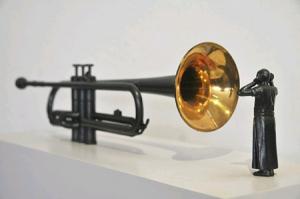Contemporary Friends started in 2013 with a goal of acquiring contemporary works of art that complement LACMA’s collections of objects that span the globe. To this end, this year’s ten acquisitions fit the bill in their diversity in not only media, but also in the parts of the world represented. Now in its second year, chaired and led by LACMA trustee Viveca Paulin-Ferrell, Contemporary Friends recently made nine important acquisitions by artists new to LACMA’s collection.
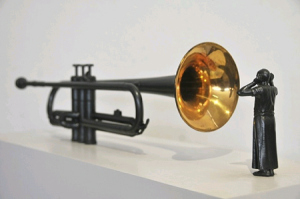 Agus Suwage, Social Mirrors, 2013, purchased with funds provided by Contemporary Friends, 2013
Agus Suwage, Social Mirrors, 2013, purchased with funds provided by Contemporary Friends, 2013
The first work by Agus Suwage to enter the collection of an American museum, Social Mirrors, from 2013, features a small figure of the artist dressed in traditional prayer attire facing a brass cornet. The sound, emitted from a car-audio system embedded into the pedestal, is assumed to come out of the bell of the cornet. The Suwage figure appears to have its hands behind its ears, in a posture of a muezzin, an individual who leads the call to prayer at a mosque.
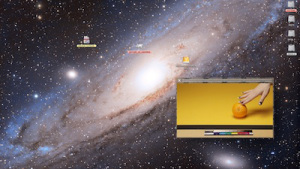 Camille Henrot, Grosse Fatigue, 2013, purchased with funds provided by Sue Tsao through Contemporary Friends, 2013
Camille Henrot, Grosse Fatigue, 2013, purchased with funds provided by Sue Tsao through Contemporary Friends, 2013
Also entering the collection is Grosse Fatigue, the Silver Lion winner at the 2013 Venice Biennale, by French artist Camille Henrot. The work takes up the history of the world as its subject, featuring a narrative that is co-written by the poet Jacob Bromberg and set to hip-hop beats by Joakim Bouaziz. Henrot attempts a feat with Grosse Fatigue—she aims to tell the story of the creation of the universe.
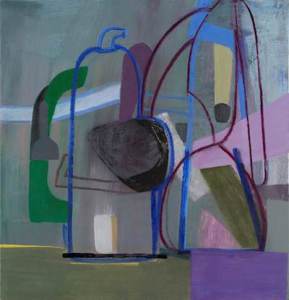 Amy Sillman, Untitled (Purple Bottle), 2013, purchased with funds provided by Contemporary Friends, 2013
Amy Sillman, Untitled (Purple Bottle), 2013, purchased with funds provided by Contemporary Friends, 2013
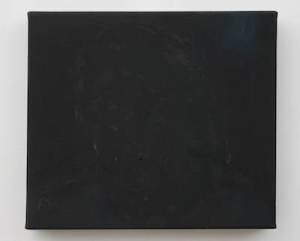 Maaike Schoorel, Ian met turban (Ian with turban), 2011,
Maaike Schoorel, Ian met turban (Ian with turban), 2011,purchased with funds provided by Emily and Teddy Greenspan through Contemporary Friends, 2013
Two paintings, one by Amy Sillman and another by Maaike Schoorel, explore different strategies in composition and subject. Amy Sillman’s work, Untitled (Purple Bottle), challenges the boundaries between abstraction and figuration, while demonstrating her skills as a formidable colorist. The canvas is comprised of various ambiguous forms and lines rendered in bold and pastel colors—pinks, greens, purples, and grays. There are gestures toward representation: the handle of the “Purple Bottle,” for instance, is implied by the green handle, but lines around it disrupt the figurative. Schoorel’s work, Ian met turban (Ian with turban), initially appears all black, but, upon closer observation, a figure—that of a head—reveals itself. The viewer is required to invest time and to focus in order to see the form in the otherwise minimalist canvas.
 Edgardo Aragón, La Trampa, 2011, purchased with funds provided by Jeanne Williams and Jason Greenman through Contemporary Friends, 2013
Edgardo Aragón, La Trampa, 2011, purchased with funds provided by Jeanne Williams and Jason Greenman through Contemporary Friends, 2013
Edgardo Aragón’s La Trampa tells the story of an Oaxacan village and looks at the landscape of this Mexican state for inspiration. Mohamed Bourouissa’s Temps Mort records a yearlong dialogue between the artist and a friend who was incarcerated for a minor offense. The video installation features mobile-phone recordings made by his friend. These two acquisitions, along with Henrot's Grosse Fatigue, not only add to the depth of our holdings of video and time-based media, but also complement LACMA’s Art+Film initiative, which aims to present the moving image in the context of an art museum.
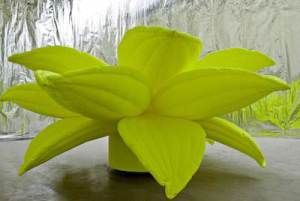 Choi Jeonghwa, Flower, Flower, 2008, purchased with funds provided by Contemporary Friends, 2013
Choi Jeonghwa, Flower, Flower, 2008, purchased with funds provided by Contemporary Friends, 2013
LACMA has been able to build its collection of contemporary Korean art thanks in part to generous support by AmorePacific. This year, Contemporary Friends was able to add Choi Jeonghwa’s Flower, Flower, two objects made both for indoor and outdoor environs. Known for his playful use of existing objects, Choi's work adds to the holdings of Korean art that span the Three Kingdoms, Goryeo, and the Joseon periods and also complement contemporary works by Korean artists such as Haegue Yang, Lee Bul, Yeesookyung, and Do Ho Suh.
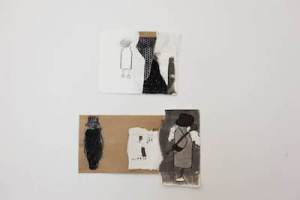 Kemang Wa Lehulere, Five Figures and Three Bottles (Even if I Bleed2), 2011, purchased with funds provided by Wyatt and Marlowe Kline, and Jay and John Lassiter through Contemporary Friends, 2013
Kemang Wa Lehulere, Five Figures and Three Bottles (Even if I Bleed2), 2011, purchased with funds provided by Wyatt and Marlowe Kline, and Jay and John Lassiter through Contemporary Friends, 2013
The young artist Kemang Wa Lehulere’s 5 Figures and Three Bottles (Even if I Bleed 2) combines two drawings with collage into one singular piece. The first drawing, at top, features a white figure that appears to be rendered in a form of a bottle. Adjacent to that figure are black-and-white layers featuring mesh-like patterns, crude scribbles, and watercolor gestures. In the second half of the piece (the bottom), a black figure, seemingly in the guise of an angel, tilts his head above, looking over a black and a white form. The push-and-pull of the forms exemplifies Lehulere's strategies in his work, which encourages the viewer to make multiple, differing interpretations as it attempts to reconcile the past and present in South Africa.
 Rashid Johnson, Four for the Talking Cure, 2009–12, purchased with funds provided Contemporary Friends, Holly and Albert Baril, Allison and Larry Berg, Viveca Paulin-Ferrell and Will Ferrell, Linda and Paul Gotskind, Jennifer Hawks and Ramin Djawadi, Laura and James Maslon, Phil Mercado and Todd Quinn, Candace and Charles Nelson, and the Kerry and Simone Vickar Foundation, 2013
Rashid Johnson, Four for the Talking Cure, 2009–12, purchased with funds provided Contemporary Friends, Holly and Albert Baril, Allison and Larry Berg, Viveca Paulin-Ferrell and Will Ferrell, Linda and Paul Gotskind, Jennifer Hawks and Ramin Djawadi, Laura and James Maslon, Phil Mercado and Todd Quinn, Candace and Charles Nelson, and the Kerry and Simone Vickar Foundation, 2013
Rashid Johnson’s Four for the Talking Cure comes from the artist’s first solo exhibition in London, where he presented an entirely distinct body of work. The piece is inspired by an imaginary space offering free psychotherapy, and challenges conventional notions of the art object and our shared cultural experiences. In using materials such as zebra skin, shea butter, and metal in Four for the Talking Cure, Johnson alludes to materials that are connected to a cultural past.
These acquisitions of work by nine artists new to LACMA’s collection reflect Contemporary Friends’ advocacy of art that spans geography, media, and cultures. The works not only reflect the encyclopedic nature of the museum, but also the commitment of our patrons to the dialogue of contemporary art. Through active engagement and vigorous dialogue, members of Contemporary Friends have added pieces that enrich Los Angeles’s holdings of art from around the world.
Franklin Sirmans, Terri and Michael Smooke Curator and Department Head of Contemporary Art



